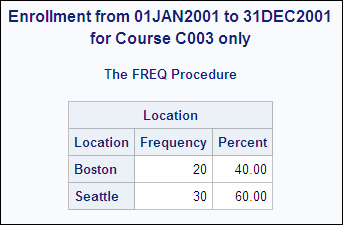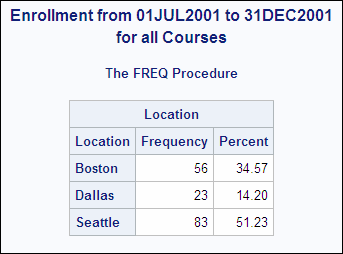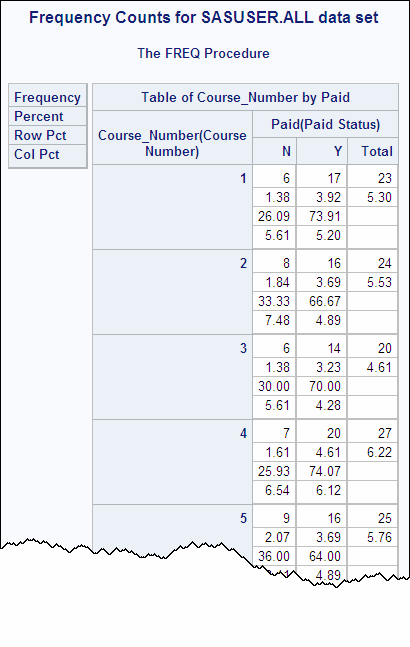Processing Statements Conditionally
Conditional Execution
You can use macros to control conditional execution
of statements. Remember the example from the beginning of this chapter
where you wanted to run a daily report to create registration listings
for courses to be held later in the month. Remember that you also
wanted to run a weekly report each Friday to create a summary of revenue
that has been generated so far in the current month. You can accomplish
these tasks with one program if you use conditional execution to determine
whether the second report should be run.
You can perform conditional
execution at the macro level with %IF-%THEN and %ELSE statements.
|
General form, %IF-%THEN
and %ELSE statements:
%IF expression %THEN text;
<%ELSE text;>
expression
can be any valid macro
expression that resolves to an integer.
text
can be specified as
|
If expression resolves
to zero, then it is false and the %THEN text is not processed (the
optional %ELSE text is processed instead). If it resolves to any integer
other than zero, then the expression is true and the %THEN text is
processed. If it resolves to null or to any noninteger value, an error
message is issued.
The %ELSE statement
is optional. However, the macro language does not contain a subsetting
%IF statement. Thus, you cannot use %IF without %THEN.
%IF-%THEN Compared to IF-THEN
Although they look similar, the %IF-%THEN/%ELSE statement
and the IF-THEN/ELSE statement belong to two different languages.
Most of the same rules that apply to the DATA step IF-THEN/ELSE statement
also apply to the %IF-%THEN/%ELSE statement. However, there are several
important differences between the macro %IF-%THEN statement and the
DATA step IF-THEN statement.
|
%IF-%THEN...
|
IF-THEN...
|
|---|---|
|
is used only in a macro
program.
|
is used only in a DATA
step program.
|
|
executes during macro
execution.
|
executes during DATA
step execution.
|
|
uses macro variables
in logical expressions and cannot refer to DATA step variables in
logical expressions.
|
uses DATA step variables
in logical expressions.
|
|
determines what text
should be copied to the input stack.
|
determines what DATA
step statement(s) should be executed. When inside a macro definition,
it is copied to the input stack as text.
|
Simple %DO and %END statements
often appear in conjunction with %IF-%THEN/%ELSE statements in order
to designate a section of the macro to be processed depending on whether
the %IF condition is true or false. Use %DO and %END statements following
%THEN or %ELSE in order to conditionally place text that contains
multiple statements onto the input stack. Each %DO statement must
be paired with an %END statement.
|
General form, %DO-%END
with %IF-%THEN and %ELSE statements:
%IF expression %THEN
%DO;
text
and/or macro language statements
%END;
%ELSE %DO;
text
and/or macro language statements
%END;
text and/or macro language statements
is either constant
text, a text expression, and/or a macro statement.
|
Note: The statements %IF-%THEN,
%ELSE, %DO, and %END are macro language statements that can be used
only inside a macro program.
Example
You can control text
that is copied to the input stack with the %IF-%THEN while controlling
DATA step logic with IF-THEN. In this example, the value of the macro
variable
status determines which variables
are included in the new data set. The value of the data set variable Location determines
the value of the new data set variable Totalfee.
%macro choice(status);
data fees;
set sasuser.all;
%if &status=PAID %then %do;
where paid='Y';
keep student_name course_code begin_date totalfee;
%end;
%else %do;
where paid='N';
keep student_name course_code
begin_date totalfee latechg;
latechg=fee*.10;
%end;
/* add local surcharge */
if location='Boston' then totalfee=fee*1.06;
else if location='Seattle' then totalfee=fee*1.025;
else if location='Dallas' then totalfee=fee*1.05;
run;
%mend choice;If the MPRINT and MLOGIC
system options are both set, the SAS log displays messages showing
the text that is sent to the compiler. For example, suppose you submit
the following macro call:
options mprint mlogic; %choice(PAID)
The following messages
are written to the log. Notice that the MLOGIC option shows the evaluation
of the expression in the %IF statement, but it does not show the evaluation
of the expression in the IF statement.
160 %choice(PAID) MLOGIC(CHOICE): Beginning execution. MLOGIC(CHOICE): Parameter STATUS has value PAID MPRINT(CHOICE): data fees; MPRINT(CHOICE): set sasuser.all; MLOGIC(CHOICE): %IF condition &status=PAID is TRUE MPRINT(CHOICE): where paid='Y'; MPRINT(CHOICE): keep student_name course_code begin_date totalfee; MPRINT(CHOICE): if location='Boston' then totalfee=fee*1.06; MPRINT(CHOICE): else if location='Seattle' then totalfee=fee*1.025; MPRINT(CHOICE): else if location='Dallas' then totalfee=fee*1.05; MPRINT(CHOICE): run; |
Suppose you submit the
following macro call:
options mprint mlogic; %choice(OWED)
The following messages
are sent to the SAS log. Notice that the text that is written to the
input stack is different this time.
161 %choice(OWED) MLOGIC(CHOICE): Beginning execution. MLOGIC(CHOICE): Parameter STATUS has value OWED MPRINT(CHOICE): data fees; MPRINT(CHOICE): set sasuser.all; MLOGIC(CHOICE): %IF condition &status=PAID is FALSE MPRINT(CHOICE): where paid='N'; MPRINT(CHOICE): keep student_name course_code begin_date totalfee latechg; MPRINT(CHOICE): latechg=fee*.10; MPRINT(CHOICE): if location='Boston' then totalfee=fee*1.06; MPRINT(CHOICE): else if location='Seattle' then totalfee=fee*1.025; MPRINT(CHOICE): else if location='Dallas' then totalfee=fee*1.05; MPRINT(CHOICE): run; |
Earlier you learned
the process that occurs when a macro program is compiled. Now that
you have seen more-complex macro programs, we can examine this process
again.
Remember that during
macro compilation, macro statements are checked for syntax errors.
If a macro definition contains macro statement syntax errors, error
messages are written to the SAS log, and a non-executable (dummy)
macro is created.
Example
Suppose you attempt
to compile a macro that contains a syntax error. For example, the
following program is missing a percent sign in the %IF-%THEN statement:
%macro printit;
%if &syslast ne _NULL_ then %do;
proc print data=_last_(obs=5);
title "Last Created Data Set Is &syslast";
run;
%end;
%mend;When you submit this
macro definition, the macro processor checks the %IF-%THEN statement
and the %DO and %END statements for syntax errors. Since there is
a syntax error in the %IF-%THEN statement, the following error messages
are written to the SAS log.
10 %macro printit; 11 %if &syslast ne _NULL_ then %do; ERROR: Macro keyword DO appears as text. A semicolon or other delimiter may be missing. ERROR: Expected %THEN statement not found. A dummy macro will be compiled. 12 proc print data=_last_(obs=5); 13 title "Last Created Data Set Is &syslast"; 14 run; 15 %end; ERROR: There is no matching %DO statement for the %END. This statement will be ignored. 16 %mend; |
Macro Execution with Conditional Processing
Earlier you learned that when the macro processor receives
%macro-name,
it executes compiled macro language statements such as %IF-%THEN.
The values of macro variables that are used within the %IF logical
expression are resolved during macro execution. The %IF logical expression
is automatically evaluated.
Example
Example
Suppose you want to
generate a report of enrollment at each training center as listed
in the data set Sasuser.All. You can specify your macro program so
that if a specific course is requested, the macro inserts a WHERE
ALSO statement in order to restrict the report to that course. This
example also customizes the second title line based on whether a course
was selected, as follows:
%macro attend(crs,start=01jan2001,stop=31dec2001);
%let start=%upcase(&start);
%let stop=%upcase(&stop);
proc freq data=sasuser.all;
where begin_date between "&start"d and "&stop"d;
table location / nocum;
title "Enrollment from &start to &stop";
%if &crs= %then %do;
title2 "for all Courses";
%end;
%else %do;
title2 "for Course &crs only";
where also course_code="&crs";
%end;
run;
%mend; Note: In the program above, the
%IF statement
%if &crs= is true when crs has
a value of null.
Suppose you submit the
following call, which specifies a specific course:
%attend(C003)
This call results in
the following output. Notice that the second title has been written
according to the %ELSE %DO statement in the macro.
18 %attend(C003) MPRINT(ATTEND): proc freq data=sasuser.all; MPRINT(ATTEND): where begin_date between "01JAN2001"d and "31DEC2001"d; MPRINT(ATTEND): table location / nocum; MPRINT(ATTEND): title "Enrollment from 01JAN2001 to 31DEC2001"; MPRINT(ATTEND): title2 "for Course C003 only"; MPRINT(ATTEND): where also course_code="C003"; NOTE: WHERE clause has been augmented. MPRINT(ATTEND): run; NOTE: Writing HTML Body file: sashtml.htm NOTE: There were 2 observations read from the data set SASUSER.SCHEDULE. WHERE (Course_Code='C003') and (Begin_Date>='01JAN2001'D and Begin_Date<='31DEC2001'D); NOTE: There were 207 observations read from the data set SASUSER.STUDENTS. NOTE: There were 434 observations read from the data set SASUSER.REGISTER. NOTE: There were 1 observations read from the data set SASUSER.COURSES. WHERE Course_Code='C003'; NOTE: There were 50 observations read from the data set SASUSER.ALL. WHERE (begin_date>='01JAN2001'D and begin_date<='31DEC2001'D) and (course_code='C003'), |
Now suppose you submit
the following call, which specifies a start date but does not specify
a course:
%attend(start=01jul2001)
This call results in
the following output. Notice that in this output, the second title
line is written according to the %IF-%THEN statement in the macro.
19 %attend(start=01jul2001)
MPRINT(ATTEND): options mprint;
MPRINT(ATTEND): proc freq data=sasuser.all;
MPRINT(ATTEND): where begin_date between "01JUL2001"d and "31DEC2001"d;
MPRINT(ATTEND): table location / nocum;
MPRINT(ATTEND): title "Enrollment from 01JUL2001 to 31DEC2001";
MPRINT(ATTEND): title2 "for all Courses";
MPRINT(ATTEND): run;
NOTE: There were 6 observations read from the data set SASUSER.SCHEDULE.
WHERE Course_Code in ('C001', 'C002', 'C003', 'C004', 'C005', 'C006') and
(Begin_Date>='01JUL2001'D and Begin_Date<='31DEC2001'D);
NOTE: There were 207 observations read from the data set SASUSER.STUDENTS.
NOTE: There were 434 observations read from the data set SASUSER.REGISTER.
NOTE: There were 6 observations read from the data set SASUSER.COURSES.
NOTE: There were 162 observations read from the data set SASUSER.ALL.
WHERE (begin_date>='01JUL2001'D and begin_date<='31DEC2001'D);
|
Example
Suppose you want to
print a table of frequency counts from a SAS data set. You can generate
either a one-way table or a two-way table, based on the value of a
macro parameter. This example creates a one-way table if only the
cols parameter
is specified in the call. It creates a two-way table if the rows parameter
is also specified. %macro counts (cols=_all_,rows=,dsn=&syslast);
title "Frequency Counts for %upcase(&dsn) data set";
proc freq data=&dsn;
tables
%if &rows ne %then &rows *;
&cols;
run;
%mend counts;Suppose you submit the
following call, which specifies both
cols and rows: %counts(dsn=sasuser.all, cols=paid, rows=course_number)
Part of the resulting
output from this call is shown below. Notice that the macro has created
a two-way table.
The log shows the generated
PROC FREQ code from this macro.
28 %counts(dsn=sasuser.all, cols=paid, rows=course_number) MPRINT(COUNTS): title "Frequency Counts for SASUSER.ALL data set"; MPRINT(COUNTS): proc freq data=sasuser.all; MPRINT(COUNTS): tables course_number * paid; MPRINT(COUNTS): run; NOTE: There were 18 observations read from the data set SASUSER.SCHEDULE. WHERE Course_Code in ('C001', 'C002', 'C003', 'C004', 'C005', 'C006'), NOTE: There were 207 observations read from the data set SASUSER.STUDENTS. NOTE: There were 434 observations read from the data set SASUSER.REGISTER. NOTE: There were 6 observations read from the data set SASUSER.COURSES. NOTE: There were 434 observations read from the data set SASUSER.ALL. NOTE: PROCEDURE FREQ used (Total process time): |
Now suppose you submit
the following call, which specifies
cols but
does not specify rows: %counts(dsn=sasuser.all, cols=paid)
The output that results
from this call is shown below. Notice that this time the macro has
created a one-way table.
The log shows the generated
TABLES statement.
29 %counts(dsn=sasuser.all, cols=paid)
MPRINT(COUNTS): title "Frequency Counts for SASUSER.ALL data set";
MPRINT(COUNTS): proc freq data=sasuser.all;
MPRINT(COUNTS): tables paid;
MPRINT(COUNTS): run;
NOTE: There were 18 observations read from the data set SASUSER.SCHEDULE.
WHERE Course_Code in ('C001', 'C002', 'C003', 'C004', 'C005', 'C006'),
NOTE: There were 207 observations read from the data set SASUSER.STUDENTS.
NOTE: There were 434 observations read from the data set SASUSER.REGISTER.
NOTE: There were 6 observations read from the data set SASUSER.COURSES.
NOTE: There were 434 observations read from the data set SASUSER.ALL.
NOTE: PROCEDURE FREQ used (Total process time):
|
Example
If you construct your
%IF statement using incorrect case in any program text, the statement
is never true. For example, the %IF statement below is always false
because
_null_ is specified in lowercase
but is always stored in SAS in uppercase: %macro prtlast;
%if &syslast=_null_ %then %do;
%put No data sets created yet.;
%end;
%else %do;
proc print;
title "Last Created Data Set is &syslast";
run;
%end;
%mend;
options mprint mlogic symbolgen;
%prtlastSuppose SYSLAST has
a value of _NULL_ when you submit this example. The following messages
are written to the SAS log.
29 %prtlast MLOGIC(PRTLAST): Beginning execution. SYMBOLGEN: Macro variable SYSLAST resolves to _NULL_ MLOGIC(PRTLAST): %IF condition &syslast = _null_ is FALSE NOTE: The SAS System stopped processing this step because of errors. NOTE: PROCEDURE PRINT used: real time 1:32.58 cpu time 0.05 seconds MPRINT(PRTLAST): proc print; ERROR: There is not a default input data set (_LAST_ is _NULL_). SYMBOLGEN: Macro variable SYSLAST resolves to _NULL_ MPRINT(PRTLAST): title "Last Created Data Set is _NULL_"; MPRINT(PRTLAST): run; NOTE: The SAS System stopped processing this step because of errors. NOTE: PROCEDURE PRINT used: real time 0.01 seconds cpu time 0.01 seconds MLOGIC(PRTLAST): Ending execution. |
Tip
The %UPCASE function is often
useful when you construct %IF statements. For more information about
the %UPCASE function, see
Introducing Macro Variables...................Content has been hidden....................
You can't read the all page of ebook, please click here login for view all page.




